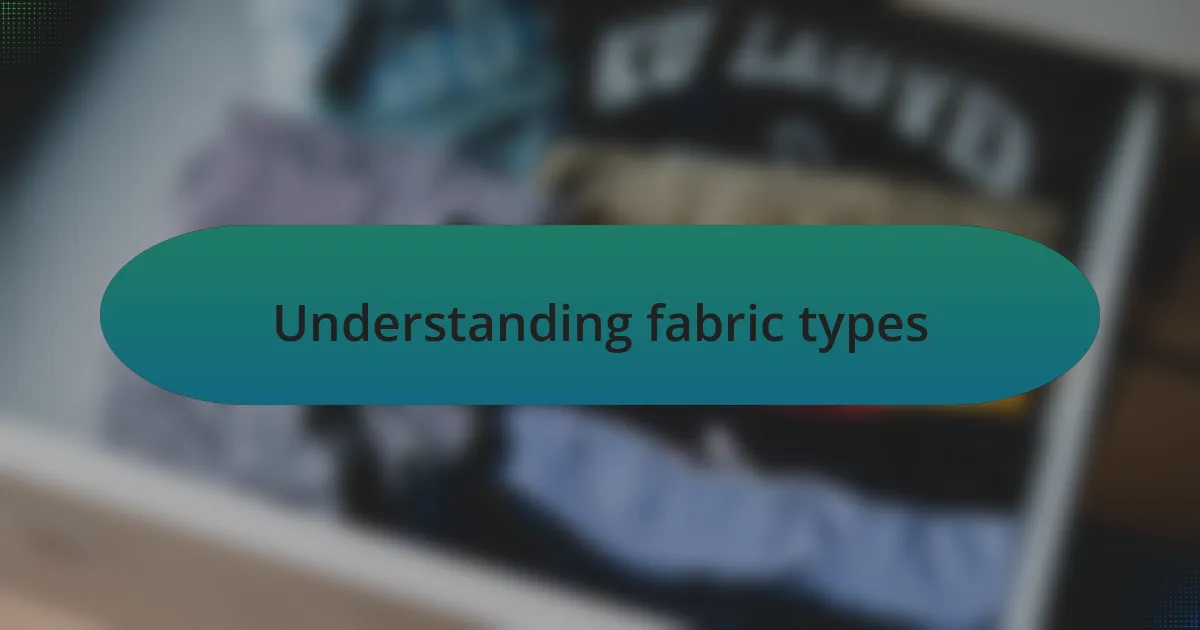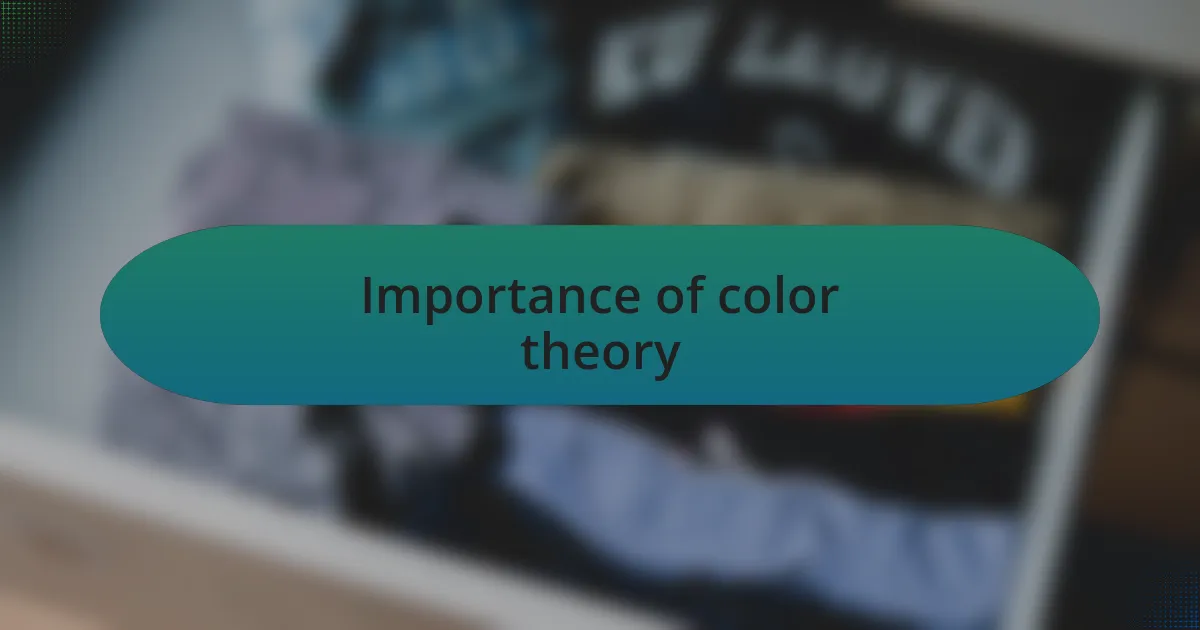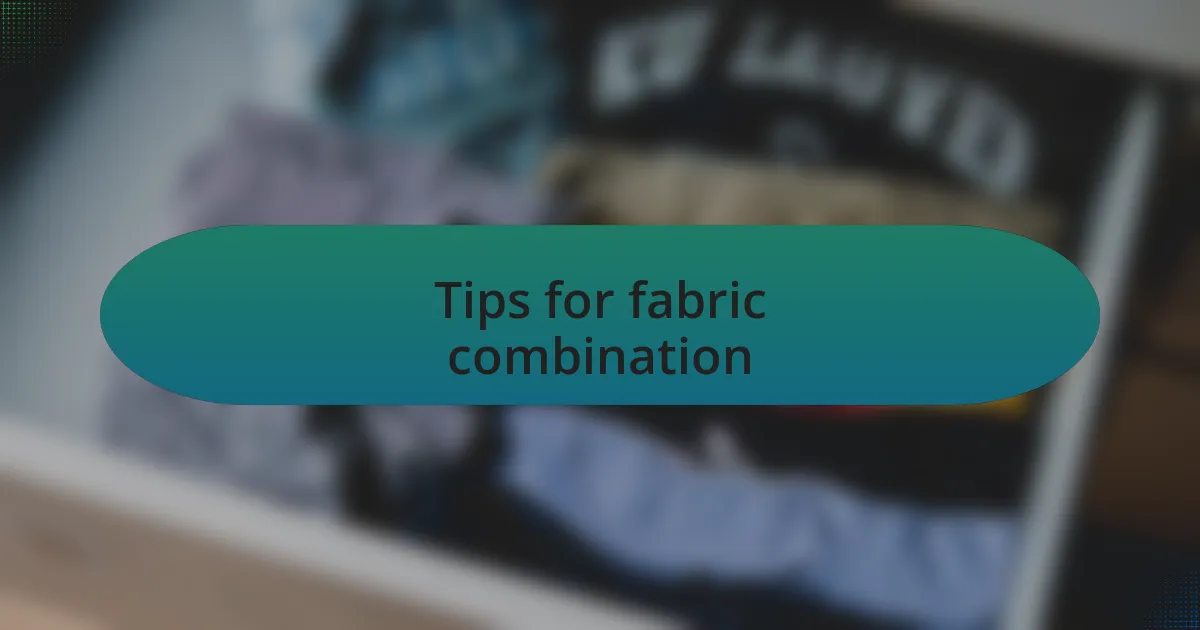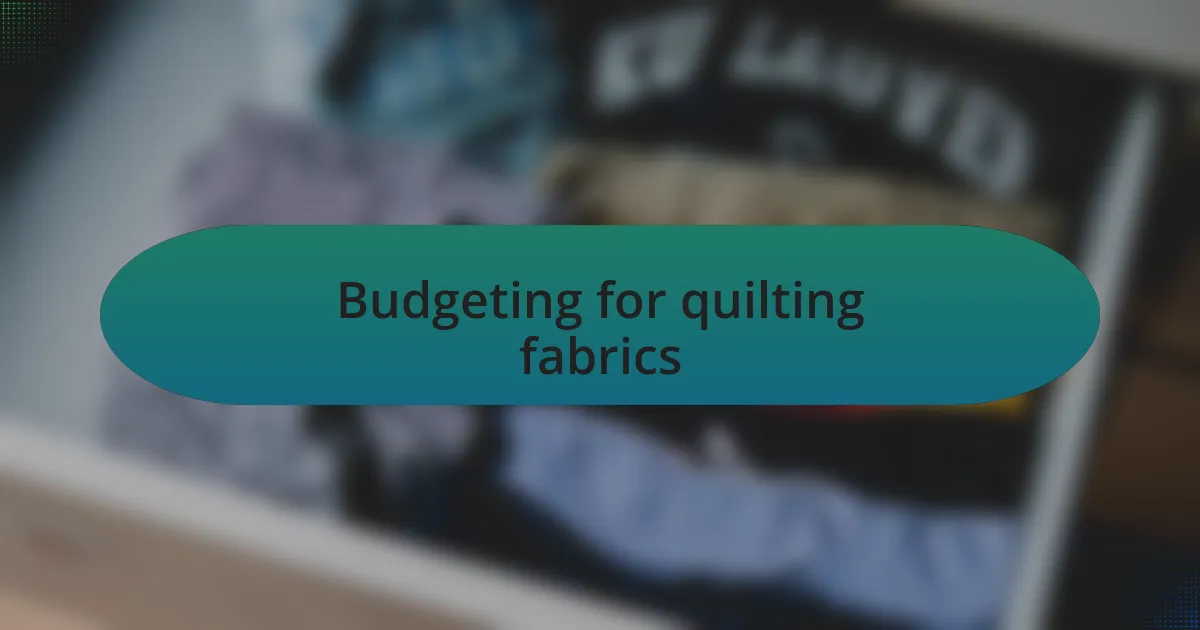Key takeaways:
- Understanding fabric types, including their breathability, durability, and suitability for intricate designs, is essential for successful quilting.
- Color theory plays a crucial role in quilt design, affecting the emotional response and storytelling aspect of the fabric choices.
- Combining contrasting fabrics, varying print scales, and textures enhances the aesthetic and tactile experience of quilts.
- Setting a budget and being strategic about fabric purchases helps manage costs while still allowing for high-quality selections.

Understanding fabric types
When diving into the world of quilting, understanding fabric types is crucial. I still remember my first quilting project where I picked a mix of cotton and polyester. I learned the hard way that cotton breathes beautifully but often wrinkles more easily, while polyester adds durability but might lack the warmth I sought for a cozy quilt. Have you ever felt fabric and instantly noticed a difference? That tactile experience shapes how we choose materials, influencing both the look and feel of our creations.
There are so many fabric types to explore—cotton, linen, silk, and blends all have unique properties that cater to different quilting styles. For instance, I often gravitate toward cotton because its versatility allows for intricate designs while maintaining that lovely drape. I once used a lightweight linen blend for a summer quilt, and while it was stylish, I realized it wasn’t the best choice for intricate piecing—awkward seams can lead to frustrations, can’t they?
On the other hand, stabilizing fabrics like fleece or batting can help refine our projects. I vividly remember using a fleece backing for a quilt I gifted to a friend; it added not only warmth but also a touch of luxury. The right choice in fabric types can transform a nice quilt into a cherished heirloom. Do you have a favorite fabric that has become a staple in your projects? I find that every quilter develops their preferences over time, influenced by experiences and results.

Importance of color theory
Color theory is an essential tool for any quilter looking to elevate their projects. I still recall the first time I paired vibrant reds with soft pastels; the contrast was striking, yet the outcome felt disjointed. It taught me that understanding how colors interact—like complementary and analogous schemes—can dramatically affect the harmony of a quilt. Have you experienced the thrill of seeing colors come alive when correctly balanced?
When selecting fabrics, I often reflect on the emotional responses different colors evoke. For example, a quilt made with warm yellows and oranges can create a cozy, inviting atmosphere, while cooler blues and greens might lend a sense of calm. I remember finishing a quilt in soothing tones for a friend’s nursery, and the moment I draped it across the crib, the whole room felt serene. Have you noticed how the mood of a space can shift with your color choices?
To me, the journey of choosing colors isn’t just about aesthetics; it’s about storytelling. Each shade brings a part of my personality into the quilt. I still treasure a patchwork quilt I created with remnants from my travels—each fabric swatch holds a memory, stirring feelings of nostalgia. As you pick your fabrics, ask yourself what story you want to tell through your color selections. How do you weave your experiences into your quilts?

Choosing fabrics for quilting
When I choose fabrics for quilting, texture plays a pivotal role in my decision-making process. I remember a quilt I made where I combined silky satin with cozy flannel. The contrast not only added visual interest but also made the quilt incredibly tactile, inviting snuggles from anyone who saw it. Have you ever touched a fabric and immediately felt inspired to create something beautiful?
Pattern selection is equally important. I tend to gravitate towards bold prints that tell a story, yet I balance them with solids to maintain cohesion. One time, I paired a whimsical floral with classic stripes—each patchwork piece contributed to a playful, contemporary vibe. What prints resonate with your personal style, and how do they inspire the narrative of your quilt?
Lastly, I often reflect on the practical aspects, like durability and washability. A quilt is meant to be loved and used, so I always select fabrics that can withstand the test of time. I recall a quilt I crafted using high-quality cotton; it has survived countless washes and still looks stunning. How do you ensure that your fabric choices will withstand the wear and tear of daily life?

Personal fabric selection process
When it comes to my personal fabric selection process, color often sets the stage for inspiration. I vividly remember a time when I stumbled upon a deep teal fabric that instantly caught my eye. It reminded me of a tranquil ocean, stirring up memories of summer beach walks. Can color evoke emotions for you as it does for me?
Next, I consider how the fabric will work together within the quilt’s overall design. One of my favorite projects involved using a mix of vintage-inspired prints along with modern geometric patterns. Playing with this combination allowed me to create depth and complexity, offering a visual feast for the eyes. How do you envision the dialogue between the different fabrics in your projects?
Finally, I always take the time to physically handle the fabrics, feeling their weight and drape. Recently, I chose a linen with a slight texture that seemed to whisper creativity as I ran my fingers over it. This tactile exploration helps me decide if a fabric will meet my quilting needs, ensuring that I end up with something not just beautiful but also functional. What sensations do you look for when selecting your fabrics?

Tips for fabric combination
When it comes to fabric combination, contrasting prints can create a stunning dynamic. I once paired a bold floral with a subtle polka dot, and the results were magical. Have you ever experimented with unexpected pairings that made your quilt come alive in a unique way?
Think about the scale of your prints as well. Mixing large-scale patterns with smaller ones can create a beautiful balance. For instance, I remember working on a project where a large paisley was complemented by tiny star motifs, which added a delightful complexity to the overall design. What scales do you normally gravitate towards in your quilts?
Don’t forget about texture’s role in fabric combinations. I’ve learned that blending smooth cottons with softer fleeces or rugged canvas can add a tactile experience to the quilt. It’s like crafting a story where each texture invites the viewer to explore a different chapter. Have you incorporated various textures into your quilting projects, and how has that impacted the final piece?

Budgeting for quilting fabrics
When budgeting for quilting fabrics, I find it essential to set a clear limit before I start shopping. This practice not only prevents impulse buys but also helps me prioritize which fabrics truly resonate with my vision. Have you ever walked into a fabric store and felt overwhelmed by choices? I certainly have, but a set budget quickly sharpens my focus.
I often browse for sales and discounts, which can make a significant difference in my overall spending. A few months ago, I discovered a local shop that had a “buy one, get one free” deal on selects cottons. It felt like finding treasure! This experience reminded me that patience pays off. Have you ever waited for the right moment to purchase fabric, only to score a deal that transformed your project?
Another strategy I employ is to allocate a portion of my budget for high-quality statement fabrics while keeping the rest for more affordable basics. This way, I can indulge in a stunning piece that can serve as a focal point in the quilt. I remember splurging on a hand-dyed fabric that became the center of a cherished quilt. It added so much depth that the cost was justifiable. How do you balance splurging on fabric with staying within your budget?

Finalizing your fabric choices
When it comes to finalizing my fabric choices, I do a little dance of sorts with my selections. I lay all the candidates out and start mixing and matching them, witnessing how they interact. Just the other day, I played with some vibrant prints alongside subdued solids, and it was fascinating to see how the dynamics shifted with each new combination. Have you ever experienced a fabric pairing that took your breath away?
I also consider the textures of the fabrics, as they can dramatically influence the final look of the quilt. For instance, last winter, I decided to incorporate a soft flannel alongside crisp quilting cottons. The contrast in feel not only enhanced the aesthetics but made that quilt incredibly cozy. Don’t you think texture can tell a story in your designs?
Finally, I always take a moment to step back and envision the final piece. This mental visualization helps me filter out fabrics that seem off in the broader scheme of things. I remember how in one project, I had a lovely floral that I adored, but it didn’t quite fit the quilt’s intended vibe. Letting go was tough, but ultimately necessary. Do you find it challenging to part with fabrics you love when they don’t fit your design?